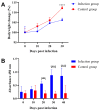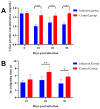Infection of Trichinella spiralis Affects the Reproductive Capacity of ICR/CD-1 Male Mice by Reducing the Urine Pheromone Contents and Sperm Quality
- PMID: 36982803
- PMCID: PMC10058773
- DOI: 10.3390/ijms24065731
Infection of Trichinella spiralis Affects the Reproductive Capacity of ICR/CD-1 Male Mice by Reducing the Urine Pheromone Contents and Sperm Quality
Abstract
Female mice can discriminate the urinary odors of male mice due to their olfactory acuity. Parasitic infection or subclinical infection can decrease the odor attractiveness of male mice and finally lead to aversion or avoidance responses in odor selection for female mice. Trichinella spiralis is a kind of tissue-parasitizing nematode that causes trichinellosis, a zoonotic parasitic disease that spreads throughout the world. However, the reproductive injury caused by Trichinella spiralis infection was not fully revealed. In this study, we explored the effect of Trichinella spiralis infection on the reproductive capacity in ICR/CD-1 male mice. We identified eight volatile compounds in urine by GC-MS analysis, and the results indicated that the contents of dimethyl sulfone, Z-7-tetradecen-1-ol, 6-Hydroxy-6-methyl-3-heptanone and (S)-2-sec-butyl-4,5-dihydrothiazole were significantly downregulated after parasitic infection, which might lead to the reduction of attractiveness of male mice urine to females. On the other hand, parasitic infection decreased sperm quality and downregulated the expression levels of Herc4, Ipo11, and Mrto4, and these genes were strongly related to spermatogenesis. In summary, this study revealed that the reproductive injury caused by Trichinella spiralis infection in ICR/CD-1 male mice could be associated with a decrease in urine pheromone content and sperm quality.
Keywords: ICR/CD-1 male mice; Trichinella spiralis; reproductive injury; sperm quality; urine pheromone content.
Conflict of interest statement
The authors declare no conflict of interest.
Figures






Similar articles
-
Infection with Cryptosporidium parvum Affects Secondary Sexual Characteristics of Male Mice by Altering the Pheromone Content in Preputial Gland.Animals (Basel). 2023 Feb 19;13(4):756. doi: 10.3390/ani13040756. Animals (Basel). 2023. PMID: 36830543 Free PMC article.
-
Time-resolved transcriptional profiling of Trichinella-infected murine myocytes helps to elucidate host-pathogen interactions in the muscle stage.Parasit Vectors. 2021 Mar 1;14(1):130. doi: 10.1186/s13071-021-04624-6. Parasit Vectors. 2021. PMID: 33648561 Free PMC article.
-
Identification and profiling of Trichinella spiralis circulating antigens and proteins in sera of mice with trichinellosis.PLoS One. 2022 Mar 10;17(3):e0265013. doi: 10.1371/journal.pone.0265013. eCollection 2022. PLoS One. 2022. PMID: 35271623 Free PMC article.
-
Induction of protection in murine experimental models against Trichinella spiralis: an up-to-date review.J Helminthol. 2015 Sep;89(5):526-39. doi: 10.1017/S0022149X15000140. Epub 2015 Mar 12. J Helminthol. 2015. PMID: 25761655 Review.
-
Biology and genome of Trichinella spiralis.WormBook. 2006 Nov 23:1-21. doi: 10.1895/wormbook.1.124.1. WormBook. 2006. PMID: 18050431 Free PMC article. Review.
Cited by
-
Effect of vitamin C injections on exercise muscular performance and biochemical parameters in Trichinella spiralis-infected mice.PeerJ. 2024 Nov 13;12:e18381. doi: 10.7717/peerj.18381. eCollection 2024. PeerJ. 2024. PMID: 39553708 Free PMC article.
-
Neurobiology of Pathogen Avoidance and Mate Choice: Current and Future Directions.Animals (Basel). 2024 Jan 17;14(2):296. doi: 10.3390/ani14020296. Animals (Basel). 2024. PMID: 38254465 Free PMC article. Review.
References
MeSH terms
Substances
Grants and funding
LinkOut - more resources
Full Text Sources
Miscellaneous

